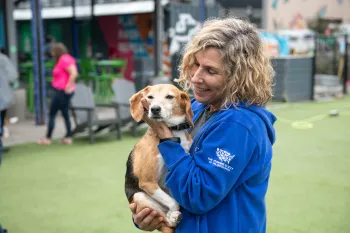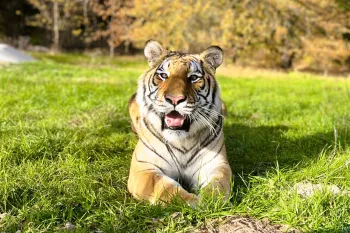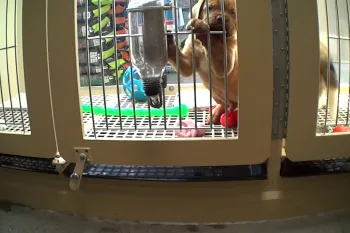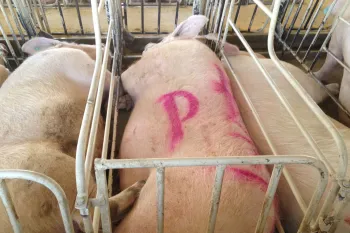Our mission is to build a more humane world, and over the past few weeks, I have been reflecting on our progress toward this vision by recounting 2023’s wins for animals of all kinds: wildlife, dogs, cats and other companion animals, animals used in labs, and animals farmed for food and for fur.
A large part of what makes progress possible depends on the way the public perceives animals and their plights. For example, in the past, people may have thought that a lethargic puppy in a pet store window was simply cute, but now such a sight is more often understood as the result of a cruel puppy mill industry where deformities and diseases are rampant.
This is thanks in large part to the media coverage our undercover investigations and Horrible Hundred reports have earned. That people increasingly view animals as deserving of fair and just treatment is nothing less than an ongoing triumph. Raising the public’s awareness of animal issues helps people make informed decisions about so many things, from the pets they bring into their homes to the products they choose at the supermarket or the department store. In this way, mass media plays a critical role in transforming our society into a better and more just system for animals.
Our media relations team works with reporters around the world every day to emphasize that issues affecting animals, far from being niche interests, are urgent and relevant. Working with reporters and promoting key newsworthy stories about animals are just a few of the myriad ways we make an impact and help build a more humane world. The team actively promotes the research, advocacy and investigations we carry out, garnering thousands of mentions in the news each year. Here are just a few of the powerful news stories about our work in 2023:
- Good Morning America did a wonderful story showing our first anniversary celebration of the rescue of nearly 4,000 beagles bred for laboratory use. FOX News and The New York Times also ran stories about these rescued beagles. High-profile news stories like these remind readers and policymakers about the urgent need to invest in non-animal research methods.
- The plight of animals who suffer on factory farms is not as well covered in the media as we might hope, but in 2023 our efforts to protect farm animals took us all the way to the U.S. Supreme Court, and that led to coverage in The Washington Post, The New York Times and scores of other news outlets. CNBC interviewed one of our experts for its piece about the egg industry, which included footage showing inhumane caging from our undercover investigation of an egg farm. And The Washington Post covered the launch of our campaign to pass a law that would protect Maryland’s food system from certain cruel and dangerous farming practices.
- If you listen to NPR, you may have heard one or two stories about why people should avoid buying puppies from unscrupulous dog breeders. Meanwhile, our media experts earned coverage about our campaign to end the dog meat trade in top Korean news outlets as well as U.S.-based outlets such as TIME and Vice.
- The Wall Street Journal’s story about trapping wildlife included a quote from our expert explaining why lethal trapping should stop. We also contributed to a Martha Stewart article about preventing human conflicts with wildlife. And National Geographic included us in its story about the importance of state animal protection laws.
- The cruel trophy hunting industry was exposed repeatedly, including in a Los Angeles Times editorial that we contributed to, and in coverage from the BBC and The New York Times.
- It was especially heartening to see members of our staff recognized for their work to protect animals. The iconic Neiman Marcus holiday catalog featured an article celebrating our anti-fur campaign lead, P.J. Smith. Meanwhile, Vox’s annual list of 50 leaders “working on solutions to today’s (and tomorrow’s) biggest problems” included our chief counsel, Jonathan Lovvorn. And Forbes issued its own list of 50 leaders, of which I was one. It was a thrill to be included in that list most of all because having the animal protection movement represented there adds to the swell of support and recognition that animals so desperately need.
Reporters have told us that of all the issues they cover, the stories that often generate the most response from audiences focus on animals. The actions of animal advocates like you help spur media coverage of animal protection issues. Your notes to TV news programs or newspapers encourage news outlets to expand their coverage of animal issues. Next time you see a news story about animals, whether it describes dogs rescued from laboratory experiments or legislation to protect wolves and bears, please drop a thank-you note to that media outlet and share these stories. In doing so, you give animals a voice.
With each news story that exposes inhumane treatment of animals, we are chipping away at the secrecy that surrounds and protects so many cruel practices. This is how progress is won in our steady march toward a more humane world.
Follow Kitty Block @HSUSKittyBlock.




